Intellectual property rights: the role of patents in
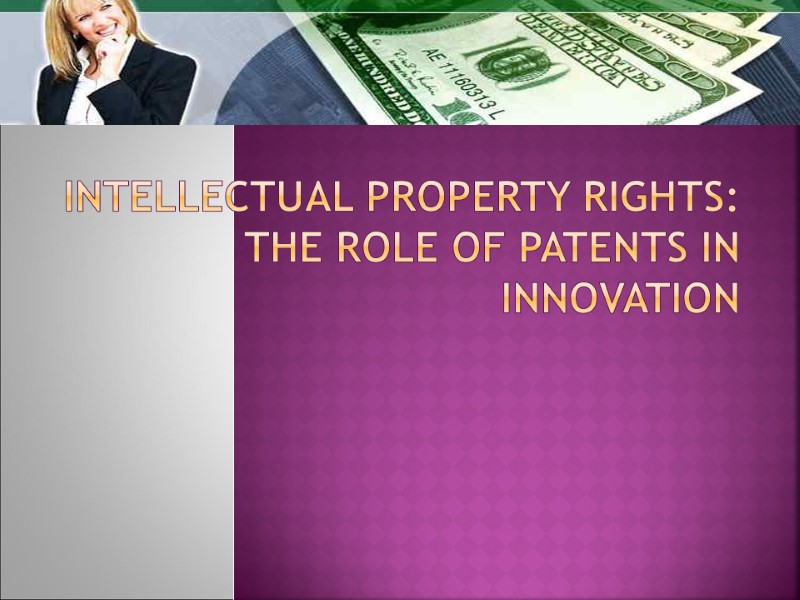
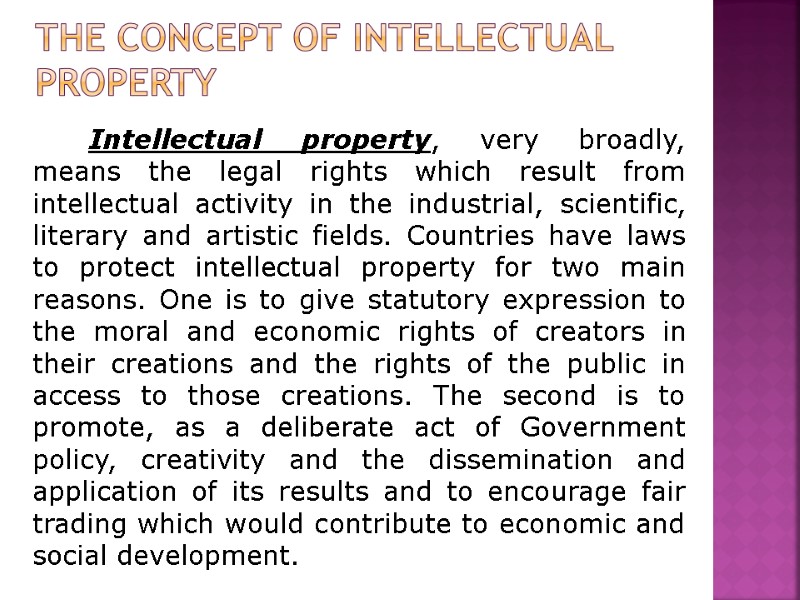
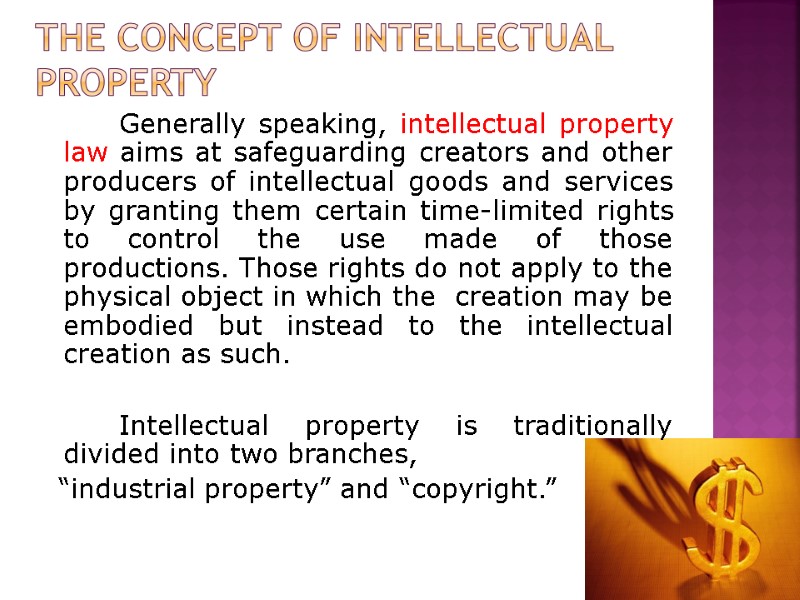
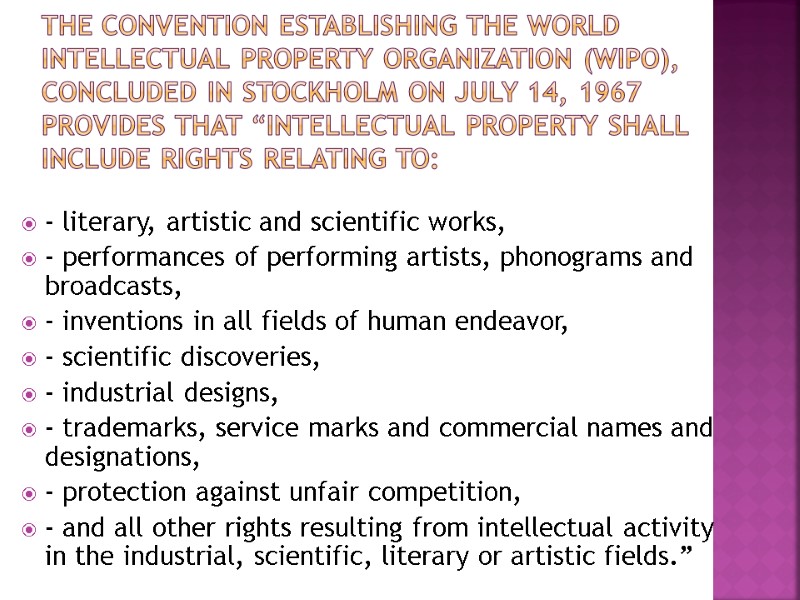
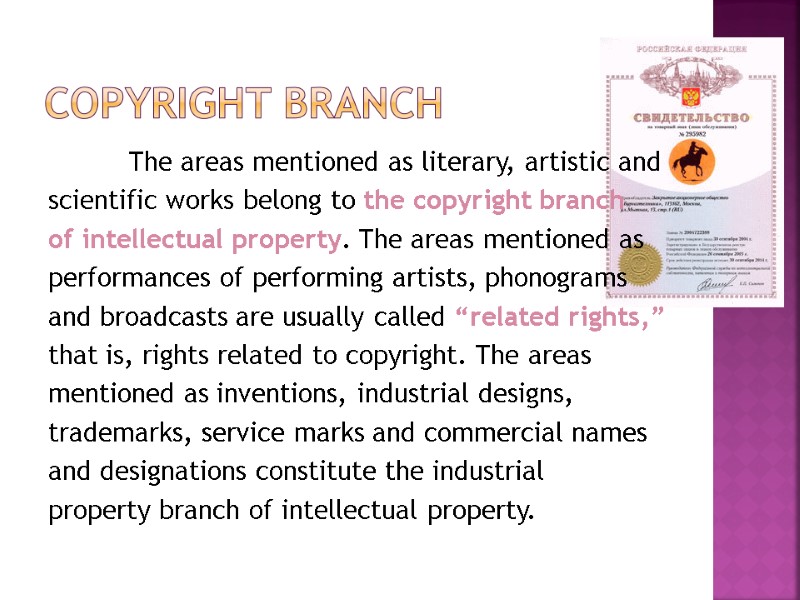

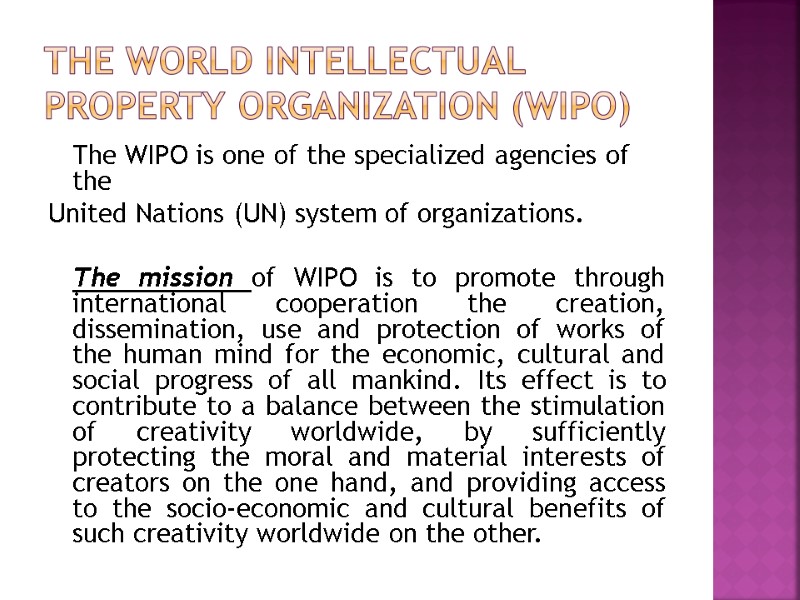
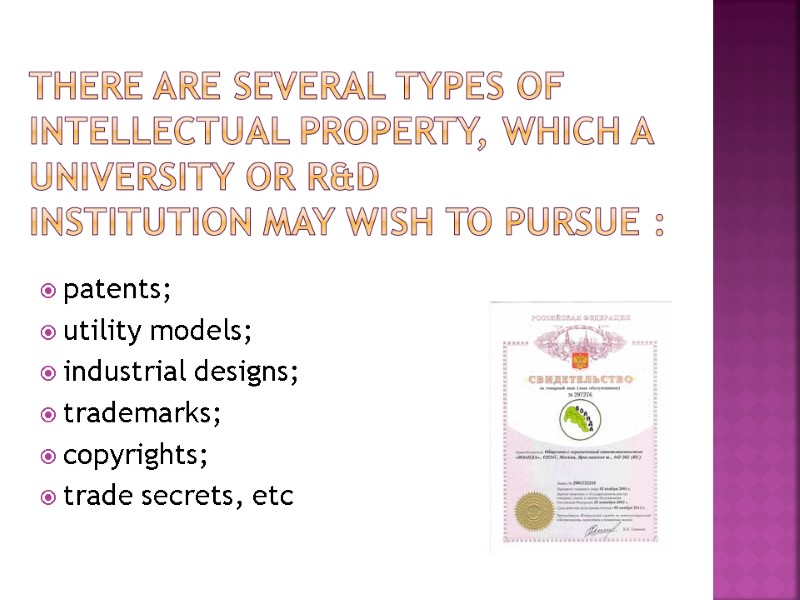
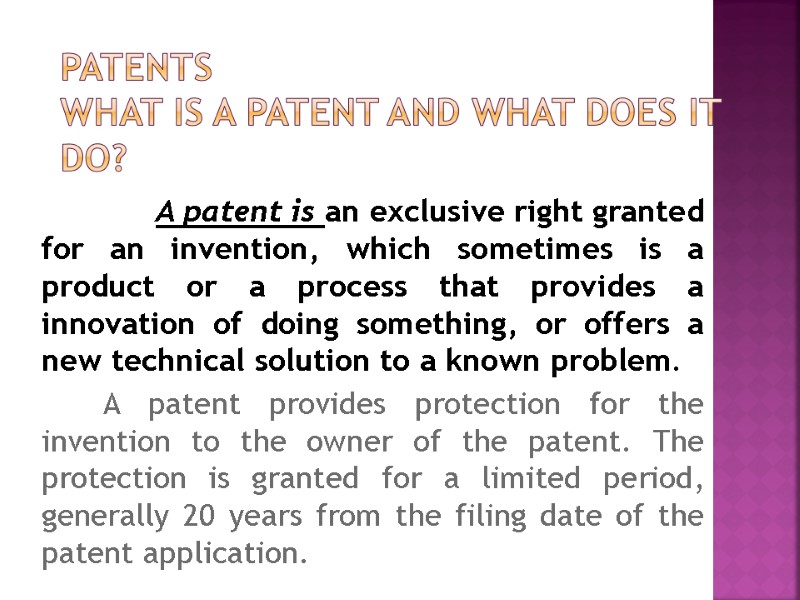
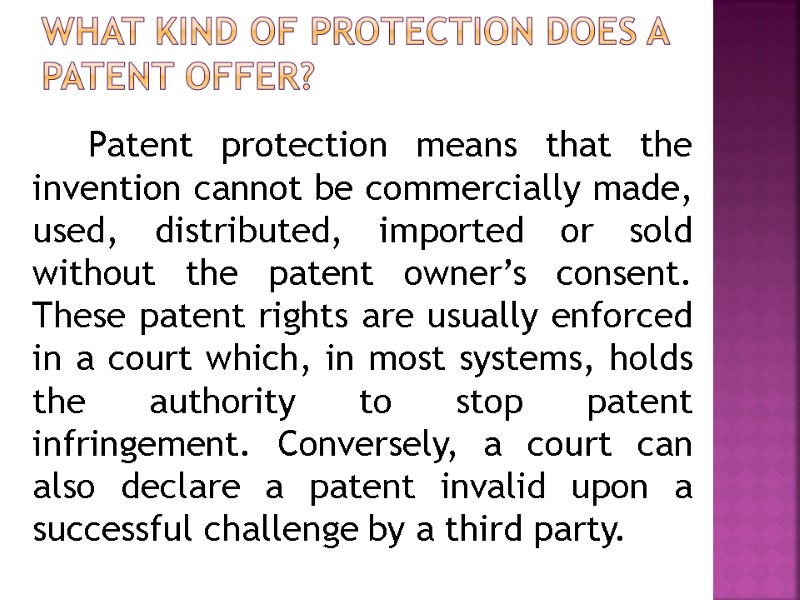
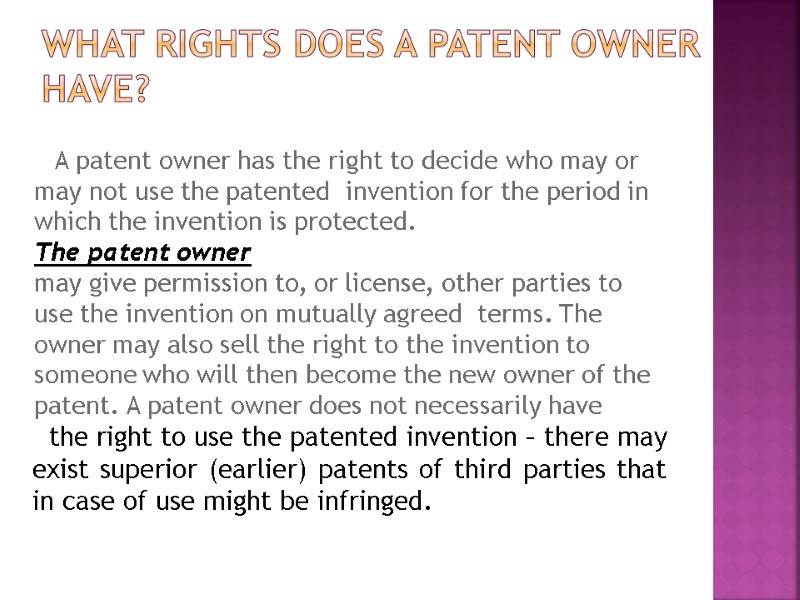
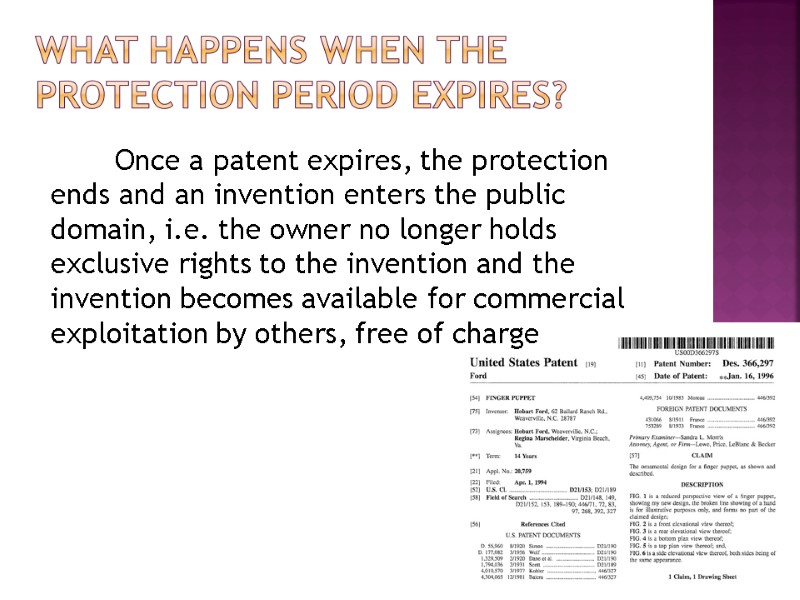
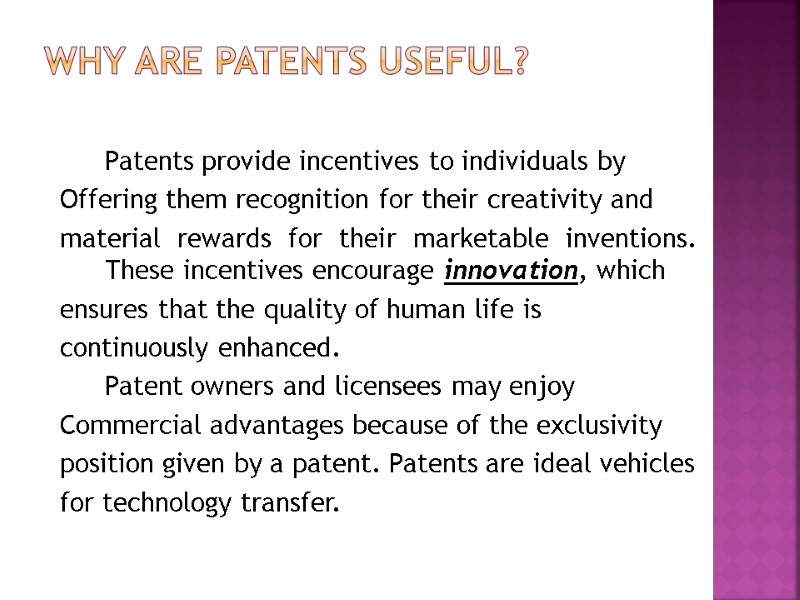
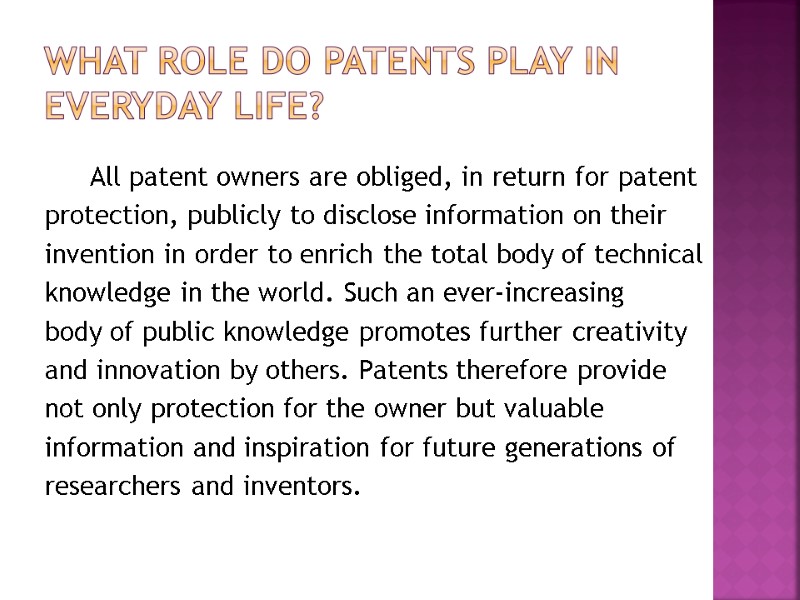
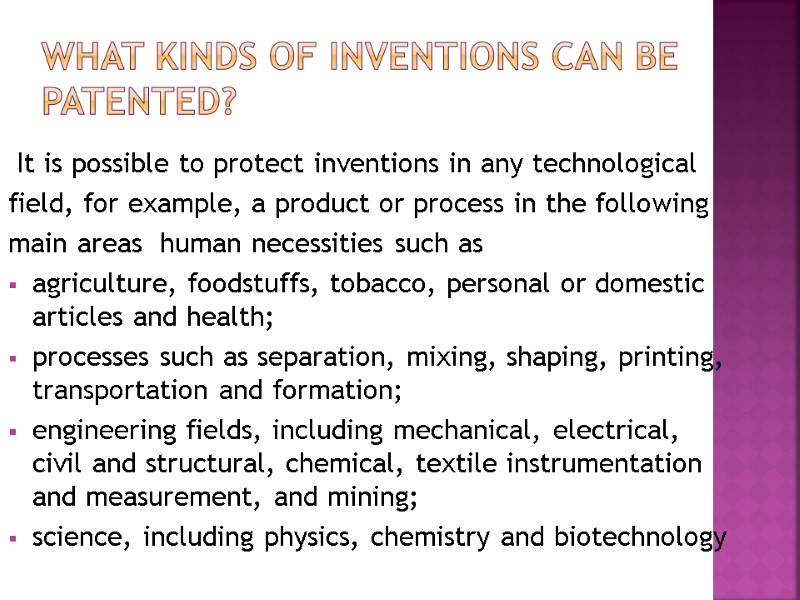
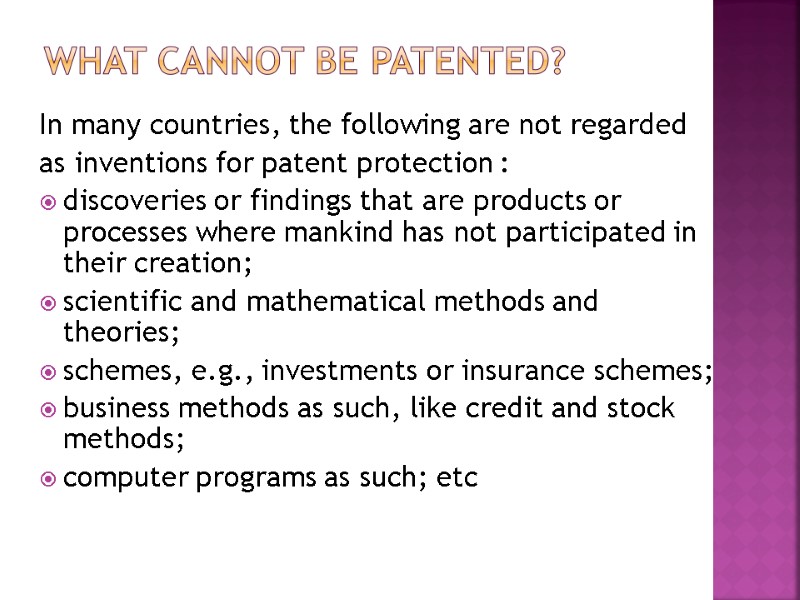
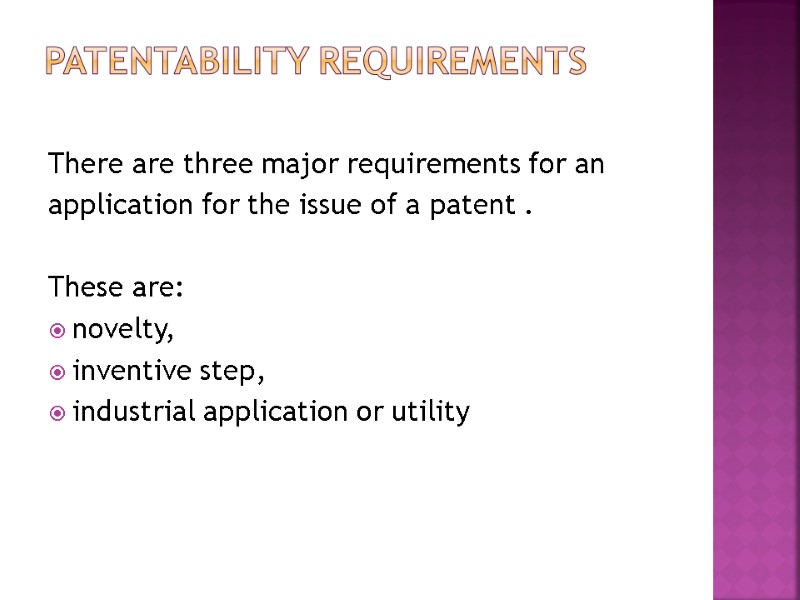
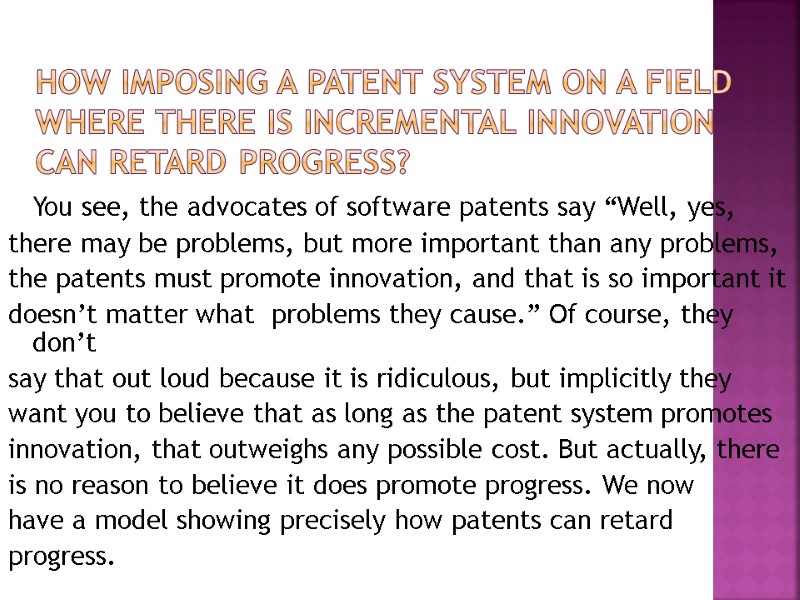
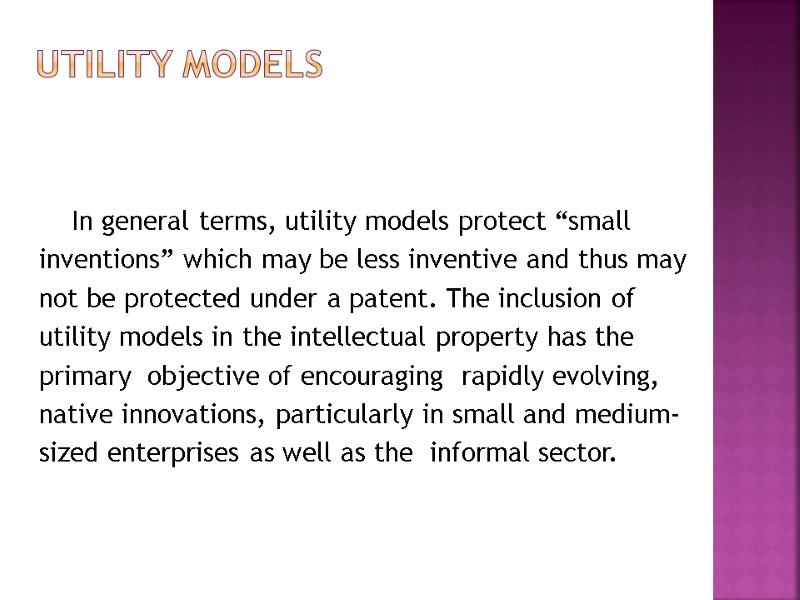


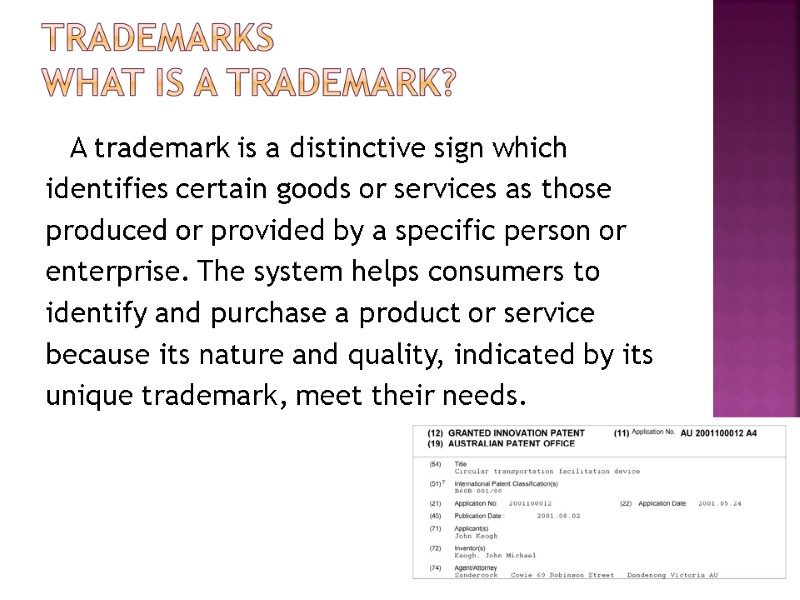
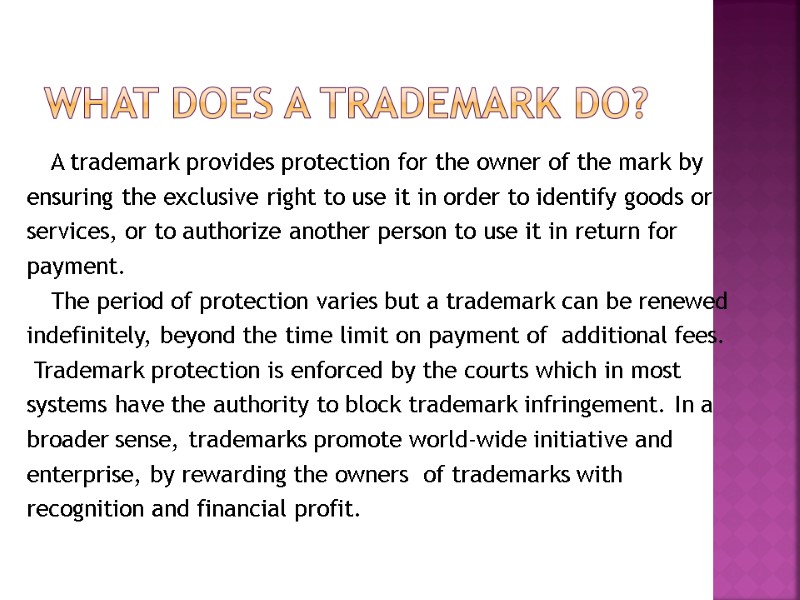
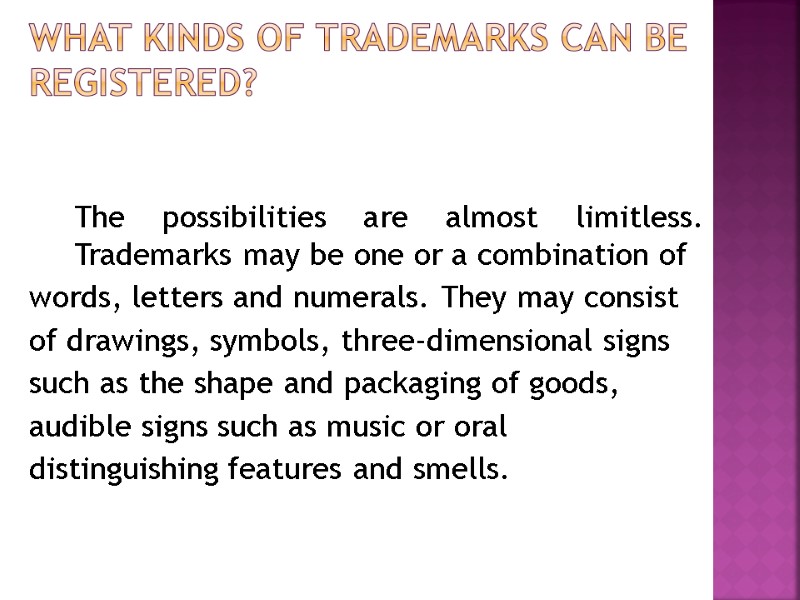
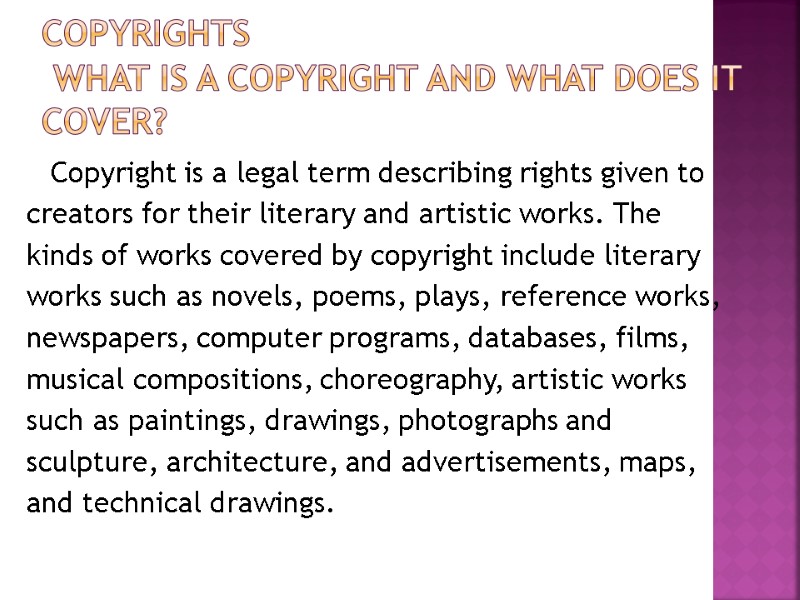
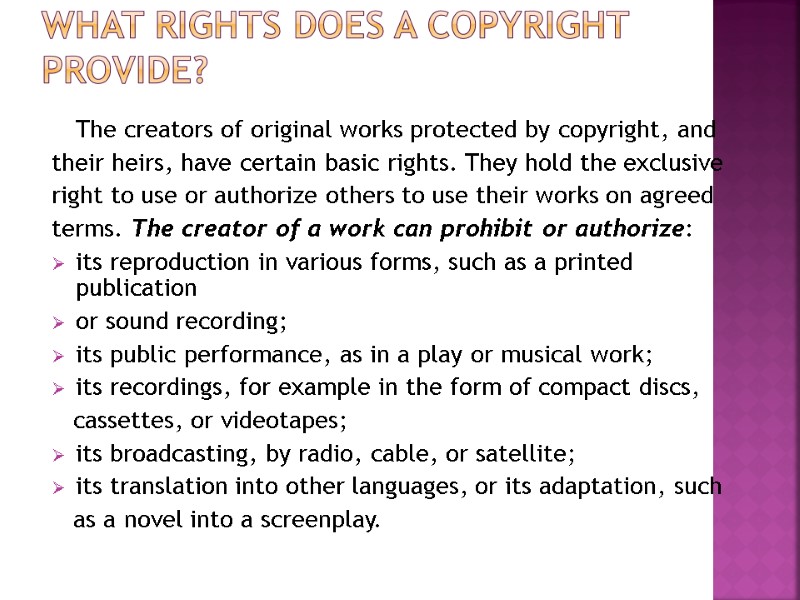
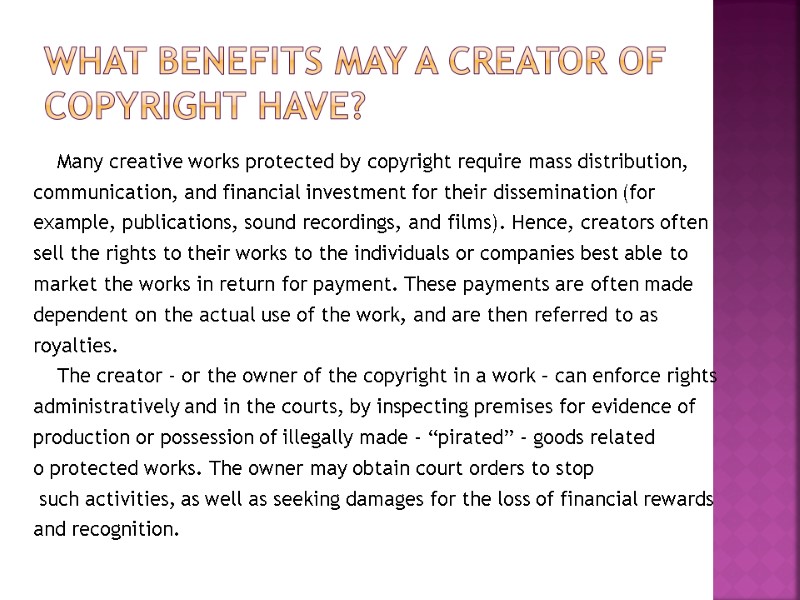
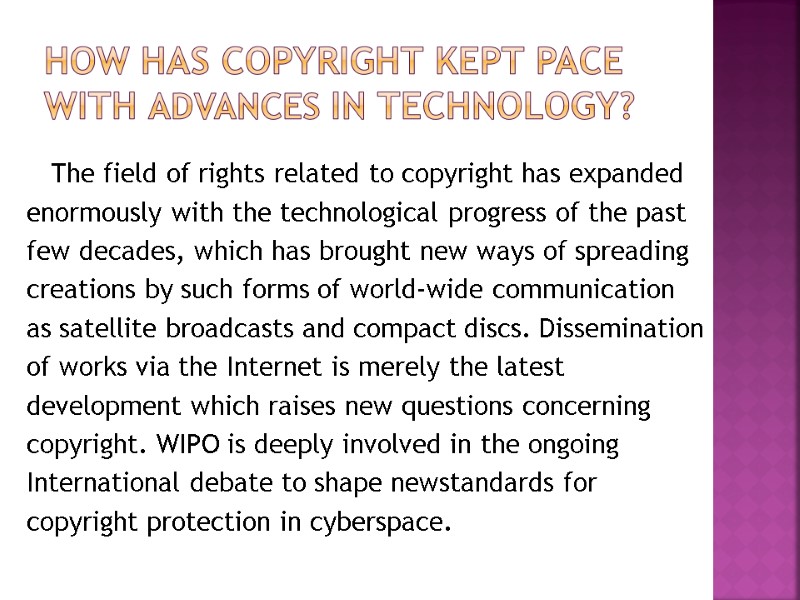
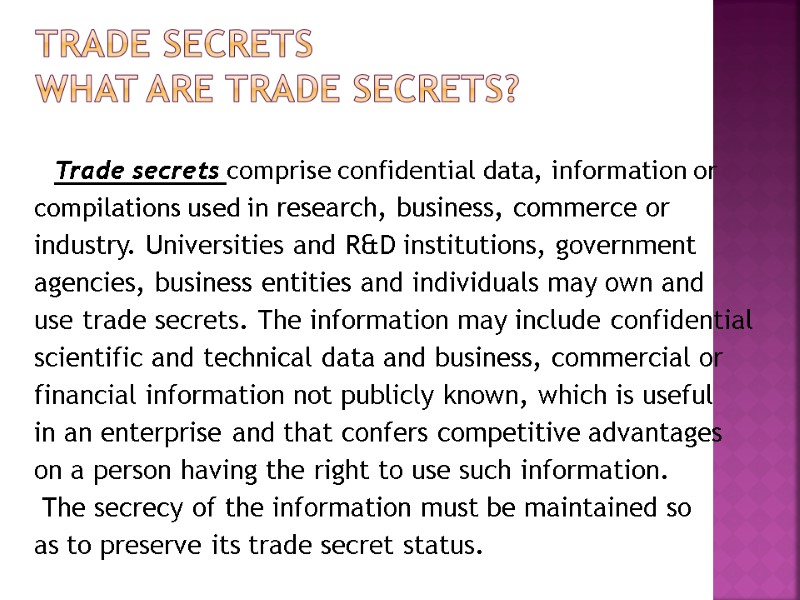
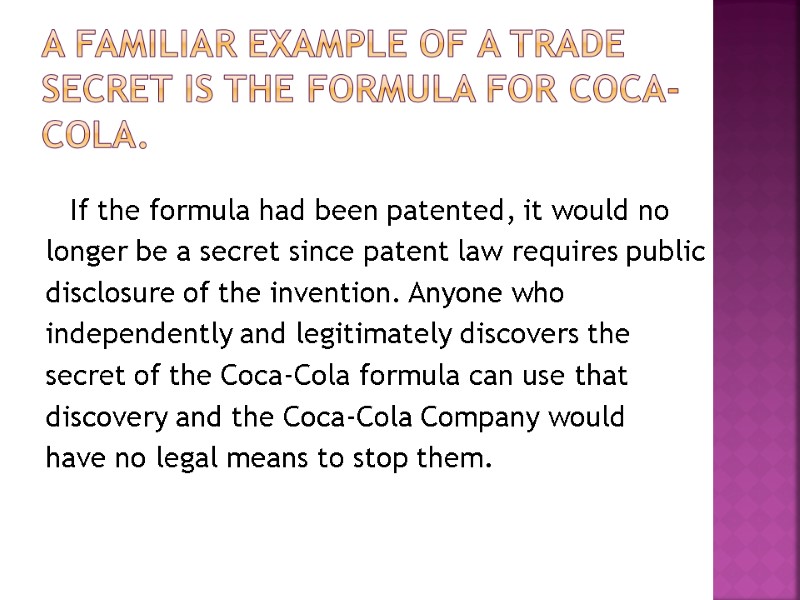

1214-2_intellectual_property_rights.ppt
- Количество слайдов: 31
 Intellectual property rights: the role of patents in innovation
Intellectual property rights: the role of patents in innovation
 The Concept of Intellectual Property Intellectual property, very broadly, means the legal rights which result from intellectual activity in the industrial, scientific, literary and artistic fields. Countries have laws to protect intellectual property for two main reasons. One is to give statutory expression to the moral and economic rights of creators in their creations and the rights of the public in access to those creations. The second is to promote, as a deliberate act of Government policy, creativity and the dissemination and application of its results and to encourage fair trading which would contribute to economic and social development.
The Concept of Intellectual Property Intellectual property, very broadly, means the legal rights which result from intellectual activity in the industrial, scientific, literary and artistic fields. Countries have laws to protect intellectual property for two main reasons. One is to give statutory expression to the moral and economic rights of creators in their creations and the rights of the public in access to those creations. The second is to promote, as a deliberate act of Government policy, creativity and the dissemination and application of its results and to encourage fair trading which would contribute to economic and social development.
 Generally speaking, intellectual property law aims at safeguarding creators and other producers of intellectual goods and services by granting them certain time-limited rights to control the use made of those productions. Those rights do not apply to the physical object in which the creation may be embodied but instead to the intellectual creation as such. Intellectual property is traditionally divided into two branches, “industrial property” and “copyright.” The Concept of Intellectual Property
Generally speaking, intellectual property law aims at safeguarding creators and other producers of intellectual goods and services by granting them certain time-limited rights to control the use made of those productions. Those rights do not apply to the physical object in which the creation may be embodied but instead to the intellectual creation as such. Intellectual property is traditionally divided into two branches, “industrial property” and “copyright.” The Concept of Intellectual Property
 The Convention Establishing the World Intellectual Property Organization (WIPO), concluded in Stockholm on July 14, 1967 provides that “intellectual property shall include rights relating to: - literary, artistic and scientific works, - performances of performing artists, phonograms and broadcasts, - inventions in all fields of human endeavor, - scientific discoveries, - industrial designs, - trademarks, service marks and commercial names and designations, - protection against unfair competition, - and all other rights resulting from intellectual activity in the industrial, scientific, literary or artistic fields.”
The Convention Establishing the World Intellectual Property Organization (WIPO), concluded in Stockholm on July 14, 1967 provides that “intellectual property shall include rights relating to: - literary, artistic and scientific works, - performances of performing artists, phonograms and broadcasts, - inventions in all fields of human endeavor, - scientific discoveries, - industrial designs, - trademarks, service marks and commercial names and designations, - protection against unfair competition, - and all other rights resulting from intellectual activity in the industrial, scientific, literary or artistic fields.”
 copyright branch The areas mentioned as literary, artistic and scientific works belong to the copyright branch of intellectual property. The areas mentioned as performances of performing artists, phonograms and broadcasts are usually called “related rights,” that is, rights related to copyright. The areas mentioned as inventions, industrial designs, trademarks, service marks and commercial names and designations constitute the industrial property branch of intellectual property.
copyright branch The areas mentioned as literary, artistic and scientific works belong to the copyright branch of intellectual property. The areas mentioned as performances of performing artists, phonograms and broadcasts are usually called “related rights,” that is, rights related to copyright. The areas mentioned as inventions, industrial designs, trademarks, service marks and commercial names and designations constitute the industrial property branch of intellectual property.
 “industrial property” The expression “industrial property” covers inventions and industrial designs. Simply stated, inventions are new solutions to technical problems and industrial designs are aesthetic creations determining the appearance of industrial products. In addition, industrial property includes trademarks, service marks, commercial names and designations, including indications of source and appellations of origin, and protection against unfair competition.
“industrial property” The expression “industrial property” covers inventions and industrial designs. Simply stated, inventions are new solutions to technical problems and industrial designs are aesthetic creations determining the appearance of industrial products. In addition, industrial property includes trademarks, service marks, commercial names and designations, including indications of source and appellations of origin, and protection against unfair competition.
 The World Intellectual Property Organization (WIPO) The WIPO is one of the specialized agencies of the United Nations (UN) system of organizations. The mission of WIPO is to promote through international cooperation the creation, dissemination, use and protection of works of the human mind for the economic, cultural and social progress of all mankind. Its effect is to contribute to a balance between the stimulation of creativity worldwide, by sufficiently protecting the moral and material interests of creators on the one hand, and providing access to the socio-economic and cultural benefits of such creativity worldwide on the other.
The World Intellectual Property Organization (WIPO) The WIPO is one of the specialized agencies of the United Nations (UN) system of organizations. The mission of WIPO is to promote through international cooperation the creation, dissemination, use and protection of works of the human mind for the economic, cultural and social progress of all mankind. Its effect is to contribute to a balance between the stimulation of creativity worldwide, by sufficiently protecting the moral and material interests of creators on the one hand, and providing access to the socio-economic and cultural benefits of such creativity worldwide on the other.
 There are several types of intellectual property, which a university or R&D institution may wish to pursue : patents; utility models; industrial designs; trademarks; copyrights; trade secrets, etc
There are several types of intellectual property, which a university or R&D institution may wish to pursue : patents; utility models; industrial designs; trademarks; copyrights; trade secrets, etc
 Patents What is a Patent and What Does it Do? A patent is an exclusive right granted for an invention, which sometimes is a product or a process that provides a innovation of doing something, or offers a new technical solution to a known problem. A patent provides protection for the invention to the owner of the patent. The protection is granted for a limited period, generally 20 years from the filing date of the patent application.
Patents What is a Patent and What Does it Do? A patent is an exclusive right granted for an invention, which sometimes is a product or a process that provides a innovation of doing something, or offers a new technical solution to a known problem. A patent provides protection for the invention to the owner of the patent. The protection is granted for a limited period, generally 20 years from the filing date of the patent application.
 What Kind of Protection Does a Patent Offer? Patent protection means that the invention cannot be commercially made, used, distributed, imported or sold without the patent owner’s consent. These patent rights are usually enforced in a court which, in most systems, holds the authority to stop patent infringement. Conversely, a court can also declare a patent invalid upon a successful challenge by a third party.
What Kind of Protection Does a Patent Offer? Patent protection means that the invention cannot be commercially made, used, distributed, imported or sold without the patent owner’s consent. These patent rights are usually enforced in a court which, in most systems, holds the authority to stop patent infringement. Conversely, a court can also declare a patent invalid upon a successful challenge by a third party.
 What Rights Does a Patent Owner Have? A patent owner has the right to decide who may or may not use the patented invention for the period in which the invention is protected. The patent owner may give permission to, or license, other parties to use the invention on mutually agreed terms. The owner may also sell the right to the invention to someone who will then become the new owner of the patent. A patent owner does not necessarily have the right to use the patented invention – there may exist superior (earlier) patents of third parties that in case of use might be infringed.
What Rights Does a Patent Owner Have? A patent owner has the right to decide who may or may not use the patented invention for the period in which the invention is protected. The patent owner may give permission to, or license, other parties to use the invention on mutually agreed terms. The owner may also sell the right to the invention to someone who will then become the new owner of the patent. A patent owner does not necessarily have the right to use the patented invention – there may exist superior (earlier) patents of third parties that in case of use might be infringed.
 What Happens When the Protection Period Expires? Once a patent expires, the protection ends and an invention enters the public domain, i.e. the owner no longer holds exclusive rights to the invention and the invention becomes available for commercial exploitation by others, free of charge
What Happens When the Protection Period Expires? Once a patent expires, the protection ends and an invention enters the public domain, i.e. the owner no longer holds exclusive rights to the invention and the invention becomes available for commercial exploitation by others, free of charge
 Why are Patents Useful? Patents provide incentives to individuals by Offering them recognition for their creativity and material rewards for their marketable inventions. These incentives encourage innovation, which ensures that the quality of human life is continuously enhanced. Patent owners and licensees may enjoy Commercial advantages because of the exclusivity position given by a patent. Patents are ideal vehicles for technology transfer.
Why are Patents Useful? Patents provide incentives to individuals by Offering them recognition for their creativity and material rewards for their marketable inventions. These incentives encourage innovation, which ensures that the quality of human life is continuously enhanced. Patent owners and licensees may enjoy Commercial advantages because of the exclusivity position given by a patent. Patents are ideal vehicles for technology transfer.
 What Role Do Patents Play in EveryDay Life? All patent owners are obliged, in return for patent protection, publicly to disclose information on their invention in order to enrich the total body of technical knowledge in the world. Such an ever-increasing body of public knowledge promotes further creativity and innovation by others. Patents therefore provide not only protection for the owner but valuable information and inspiration for future generations of researchers and inventors.
What Role Do Patents Play in EveryDay Life? All patent owners are obliged, in return for patent protection, publicly to disclose information on their invention in order to enrich the total body of technical knowledge in the world. Such an ever-increasing body of public knowledge promotes further creativity and innovation by others. Patents therefore provide not only protection for the owner but valuable information and inspiration for future generations of researchers and inventors.
 What Kinds of Inventions Can Be Patented? It is possible to protect inventions in any technological field, for example, a product or process in the following main areas human necessities such as agriculture, foodstuffs, tobacco, personal or domestic articles and health; processes such as separation, mixing, shaping, printing, transportation and formation; engineering fields, including mechanical, electrical, civil and structural, chemical, textile instrumentation and measurement, and mining; science, including physics, chemistry and biotechnology
What Kinds of Inventions Can Be Patented? It is possible to protect inventions in any technological field, for example, a product or process in the following main areas human necessities such as agriculture, foodstuffs, tobacco, personal or domestic articles and health; processes such as separation, mixing, shaping, printing, transportation and formation; engineering fields, including mechanical, electrical, civil and structural, chemical, textile instrumentation and measurement, and mining; science, including physics, chemistry and biotechnology
 What Cannot be Patented? In many countries, the following are not regarded as inventions for patent protection : discoveries or findings that are products or processes where mankind has not participated in their creation; scientific and mathematical methods and theories; schemes, e.g., investments or insurance schemes; business methods as such, like credit and stock methods; computer programs as such; etc
What Cannot be Patented? In many countries, the following are not regarded as inventions for patent protection : discoveries or findings that are products or processes where mankind has not participated in their creation; scientific and mathematical methods and theories; schemes, e.g., investments or insurance schemes; business methods as such, like credit and stock methods; computer programs as such; etc
 Patentability Requirements There are three major requirements for an application for the issue of a patent . These are: novelty, inventive step, industrial application or utility
Patentability Requirements There are three major requirements for an application for the issue of a patent . These are: novelty, inventive step, industrial application or utility
 How imposing a patent system on a field where there is incremental innovation can retard progress? You see, the advocates of software patents say “Well, yes, there may be problems, but more important than any problems, the patents must promote innovation, and that is so important it doesn’t matter what problems they cause.” Of course, they don’t say that out loud because it is ridiculous, but implicitly they want you to believe that as long as the patent system promotes innovation, that outweighs any possible cost. But actually, there is no reason to believe it does promote progress. We now have a model showing precisely how patents can retard progress.
How imposing a patent system on a field where there is incremental innovation can retard progress? You see, the advocates of software patents say “Well, yes, there may be problems, but more important than any problems, the patents must promote innovation, and that is so important it doesn’t matter what problems they cause.” Of course, they don’t say that out loud because it is ridiculous, but implicitly they want you to believe that as long as the patent system promotes innovation, that outweighs any possible cost. But actually, there is no reason to believe it does promote progress. We now have a model showing precisely how patents can retard progress.
 Utility Models In general terms, utility models protect “small inventions” which may be less inventive and thus may not be protected under a patent. The inclusion of utility models in the intellectual property has the primary objective of encouraging rapidly evolving, native innovations, particularly in small and medium- sized enterprises as well as the informal sector.
Utility Models In general terms, utility models protect “small inventions” which may be less inventive and thus may not be protected under a patent. The inclusion of utility models in the intellectual property has the primary objective of encouraging rapidly evolving, native innovations, particularly in small and medium- sized enterprises as well as the informal sector.
 Industrial Designs What is an Industrial Design? An industrial design is the ornamental or aesthetic aspect. The design may consist of three-dimensional features, such as the shape or surface of an article, or of two-dimensional features, such as patterns, lines or color. Industrial designs are applied to a wide variety of products from industry and handicrafts: from technical and medical instruments to watches, jewelry and other luxury items; from domestic wares and electrical appliances to vehicles and architectural structures; from textile designs to leisure goods. To achieve protection under most national laws, an industrial design must appeal to the eye. This means that an industrial design is primarily of an aesthetic nature and does not protect any technical features of the article to which it is applied
Industrial Designs What is an Industrial Design? An industrial design is the ornamental or aesthetic aspect. The design may consist of three-dimensional features, such as the shape or surface of an article, or of two-dimensional features, such as patterns, lines or color. Industrial designs are applied to a wide variety of products from industry and handicrafts: from technical and medical instruments to watches, jewelry and other luxury items; from domestic wares and electrical appliances to vehicles and architectural structures; from textile designs to leisure goods. To achieve protection under most national laws, an industrial design must appeal to the eye. This means that an industrial design is primarily of an aesthetic nature and does not protect any technical features of the article to which it is applied
 Why Protect Industrial Designs? Industrial designs are what make an article attractive and appealing, hence they add to the commercial value of a product and increase its marketability. When an industrial design is protected, the owner - the person or entity that has registered the design - is guaranteed an exclusive right against unauthorized copying or imitation of the design by third parties and in some countries (like in the European Union) even protects in an absolute sense, like a patent against unauthorized use by others. This helps to ensure a fair return on investment.
Why Protect Industrial Designs? Industrial designs are what make an article attractive and appealing, hence they add to the commercial value of a product and increase its marketability. When an industrial design is protected, the owner - the person or entity that has registered the design - is guaranteed an exclusive right against unauthorized copying or imitation of the design by third parties and in some countries (like in the European Union) even protects in an absolute sense, like a patent against unauthorized use by others. This helps to ensure a fair return on investment.
 Trademarks What is a Trademark? A trademark is a distinctive sign which identifies certain goods or services as those produced or provided by a specific person or enterprise. The system helps consumers to identify and purchase a product or service because its nature and quality, indicated by its unique trademark, meet their needs.
Trademarks What is a Trademark? A trademark is a distinctive sign which identifies certain goods or services as those produced or provided by a specific person or enterprise. The system helps consumers to identify and purchase a product or service because its nature and quality, indicated by its unique trademark, meet their needs.
 What Does a Trademark Do? A trademark provides protection for the owner of the mark by ensuring the exclusive right to use it in order to identify goods or services, or to authorize another person to use it in return for payment. The period of protection varies but a trademark can be renewed indefinitely, beyond the time limit on payment of additional fees. Trademark protection is enforced by the courts which in most systems have the authority to block trademark infringement. In a broader sense, trademarks promote world-wide initiative and enterprise, by rewarding the owners of trademarks with recognition and financial profit.
What Does a Trademark Do? A trademark provides protection for the owner of the mark by ensuring the exclusive right to use it in order to identify goods or services, or to authorize another person to use it in return for payment. The period of protection varies but a trademark can be renewed indefinitely, beyond the time limit on payment of additional fees. Trademark protection is enforced by the courts which in most systems have the authority to block trademark infringement. In a broader sense, trademarks promote world-wide initiative and enterprise, by rewarding the owners of trademarks with recognition and financial profit.
 What Kinds of Trademarks Can Be Registered? The possibilities are almost limitless. Trademarks may be one or a combination of words, letters and numerals. They may consist of drawings, symbols, three-dimensional signs such as the shape and packaging of goods, audible signs such as music or oral distinguishing features and smells.
What Kinds of Trademarks Can Be Registered? The possibilities are almost limitless. Trademarks may be one or a combination of words, letters and numerals. They may consist of drawings, symbols, three-dimensional signs such as the shape and packaging of goods, audible signs such as music or oral distinguishing features and smells.
 Copyrights What is a Copyright and What Does it Cover? Copyright is a legal term describing rights given to creators for their literary and artistic works. The kinds of works covered by copyright include literary works such as novels, poems, plays, reference works, newspapers, computer programs, databases, films, musical compositions, choreography, artistic works such as paintings, drawings, photographs and sculpture, architecture, and advertisements, maps, and technical drawings.
Copyrights What is a Copyright and What Does it Cover? Copyright is a legal term describing rights given to creators for their literary and artistic works. The kinds of works covered by copyright include literary works such as novels, poems, plays, reference works, newspapers, computer programs, databases, films, musical compositions, choreography, artistic works such as paintings, drawings, photographs and sculpture, architecture, and advertisements, maps, and technical drawings.
 What Rights Does a Copyright Provide? The creators of original works protected by copyright, and their heirs, have certain basic rights. They hold the exclusive right to use or authorize others to use their works on agreed terms. The creator of a work can prohibit or authorize: its reproduction in various forms, such as a printed publication or sound recording; its public performance, as in a play or musical work; its recordings, for example in the form of compact discs, cassettes, or videotapes; its broadcasting, by radio, cable, or satellite; its translation into other languages, or its adaptation, such as a novel into a screenplay.
What Rights Does a Copyright Provide? The creators of original works protected by copyright, and their heirs, have certain basic rights. They hold the exclusive right to use or authorize others to use their works on agreed terms. The creator of a work can prohibit or authorize: its reproduction in various forms, such as a printed publication or sound recording; its public performance, as in a play or musical work; its recordings, for example in the form of compact discs, cassettes, or videotapes; its broadcasting, by radio, cable, or satellite; its translation into other languages, or its adaptation, such as a novel into a screenplay.
 What Benefits May a Creator of Copyright Have? Many creative works protected by copyright require mass distribution, communication, and financial investment for their dissemination (for example, publications, sound recordings, and films). Hence, creators often sell the rights to their works to the individuals or companies best able to market the works in return for payment. These payments are often made dependent on the actual use of the work, and are then referred to as royalties. The creator - or the owner of the copyright in a work – can enforce rights administratively and in the courts, by inspecting premises for evidence of production or possession of illegally made - “pirated” - goods related o protected works. The owner may obtain court orders to stop such activities, as well as seeking damages for the loss of financial rewards and recognition.
What Benefits May a Creator of Copyright Have? Many creative works protected by copyright require mass distribution, communication, and financial investment for their dissemination (for example, publications, sound recordings, and films). Hence, creators often sell the rights to their works to the individuals or companies best able to market the works in return for payment. These payments are often made dependent on the actual use of the work, and are then referred to as royalties. The creator - or the owner of the copyright in a work – can enforce rights administratively and in the courts, by inspecting premises for evidence of production or possession of illegally made - “pirated” - goods related o protected works. The owner may obtain court orders to stop such activities, as well as seeking damages for the loss of financial rewards and recognition.
 How Has Copyright Kept Pace With Advances in Technology? The field of rights related to copyright has expanded enormously with the technological progress of the past few decades, which has brought new ways of spreading creations by such forms of world-wide communication as satellite broadcasts and compact discs. Dissemination of works via the Internet is merely the latest development which raises new questions concerning copyright. WIPO is deeply involved in the ongoing International debate to shape newstandards for copyright protection in cyberspace.
How Has Copyright Kept Pace With Advances in Technology? The field of rights related to copyright has expanded enormously with the technological progress of the past few decades, which has brought new ways of spreading creations by such forms of world-wide communication as satellite broadcasts and compact discs. Dissemination of works via the Internet is merely the latest development which raises new questions concerning copyright. WIPO is deeply involved in the ongoing International debate to shape newstandards for copyright protection in cyberspace.
 Trade Secrets What Are Trade Secrets? Trade secrets comprise confidential data, information or compilations used in research, business, commerce or industry. Universities and R&D institutions, government agencies, business entities and individuals may own and use trade secrets. The information may include confidential scientific and technical data and business, commercial or financial information not publicly known, which is useful in an enterprise and that confers competitive advantages on a person having the right to use such information. The secrecy of the information must be maintained so as to preserve its trade secret status.
Trade Secrets What Are Trade Secrets? Trade secrets comprise confidential data, information or compilations used in research, business, commerce or industry. Universities and R&D institutions, government agencies, business entities and individuals may own and use trade secrets. The information may include confidential scientific and technical data and business, commercial or financial information not publicly known, which is useful in an enterprise and that confers competitive advantages on a person having the right to use such information. The secrecy of the information must be maintained so as to preserve its trade secret status.
 A familiar example of a trade secret is the formula for Coca-Cola. If the formula had been patented, it would no longer be a secret since patent law requires public disclosure of the invention. Anyone who independently and legitimately discovers the secret of the Coca-Cola formula can use that discovery and the Coca-Cola Company would have no legal means to stop them.
A familiar example of a trade secret is the formula for Coca-Cola. If the formula had been patented, it would no longer be a secret since patent law requires public disclosure of the invention. Anyone who independently and legitimately discovers the secret of the Coca-Cola formula can use that discovery and the Coca-Cola Company would have no legal means to stop them.
 Thank you for the attention!!!
Thank you for the attention!!!
